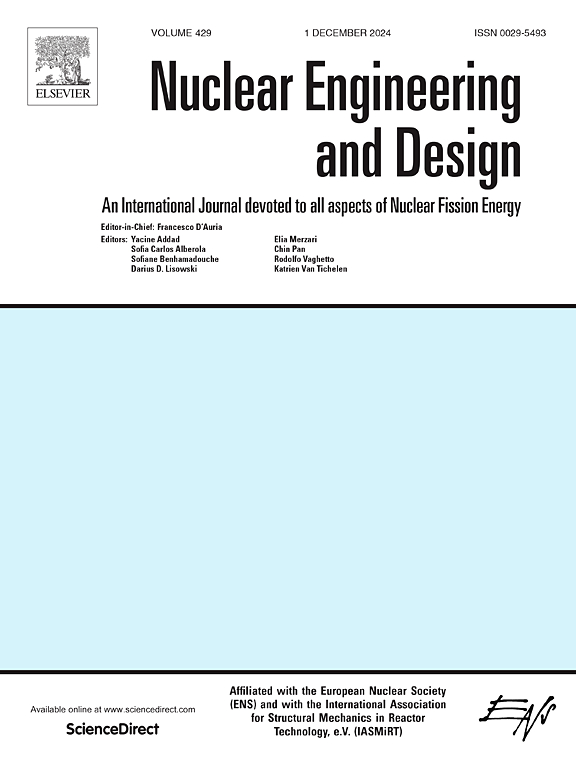Surface decontamination of uranium using a starch-based magnetic strippable hydrogel
IF 2.1
3区 工程技术
Q1 NUCLEAR SCIENCE & TECHNOLOGY
引用次数: 0
Abstract
Strippable hydrogels are recognized as promising candidates for radioactive decontamination applications owing to their non-generation of liquid waste, negligible substrate damage potential, and scalable deployment characteristics. Nevertheless, limitations persist in conventional hydrogel systems regarding the retrieval of desiccated film residues. In this study, a starch/Fe3O4 composite hydrogel was developed through a one-pot polymerization methodology that capitalizes on the inherent non-toxicity of starch constituents and the magnetophoretic properties of Fe3O4 nanoparticles. The synthesized hydrogel demonstrated pronounced embrittlement characteristics upon dehydration, attaining a saturation magnetization value of 2.98 emu/g (at 4 % Fe3O4 loading), which facilitated magnetic recovery operations with retrieval efficiencies exceeding 96.67 %. Uranium decontamination efficiencies were quantified across multiple substrates, yielding values of 89.62 % for ceramic, 81.33 % for glass, 83.93 % for steel, 68.95 % for rubber, 54.64 % for paint, and 11.82 % for concrete. Rheological characterization revealed shear-thinning behavior, with viscosity reduced to 93.21 mPa·s under shear stress conditions, thereby enabling effective spray deposition. The Application trial demonstrated that starch/F3O4 hydrogel can be successfully applied to the concrete surface by spraying, and brittle fracture can be recycled by magnets. This investigation establishes a sustainable decontamination paradigm through the synergistic integration of magnetically assisted recovery mechanisms with the adsorptive capacity of starch-based matrices, addressing both operational efficacy and post-treatment waste management challenges.

用淀粉基磁性可剥离水凝胶对铀进行表面净化
可剥离水凝胶由于其不产生废液、可忽略的基材损伤潜力和可扩展的部署特性,被认为是放射性去污应用的有前途的候选者。然而,传统的水凝胶系统在回收干燥膜残留物方面仍然存在局限性。在这项研究中,淀粉/Fe3O4复合水凝胶是通过一锅聚合方法开发的,该方法利用了淀粉成分固有的无毒性和Fe3O4纳米颗粒的磁性。制备的水凝胶脱水后表现出明显的脆性特征,饱和磁化强度为2.98 emu/g(含Fe3O4为4%),有利于磁回收作业,回收率超过96.67%。对多种基材的铀去污效率进行了量化,陶瓷的去污效率为89.62%,玻璃为81.33%,钢铁为83.93%,橡胶为68.95%,油漆为54.64%,混凝土为11.82%。流变学表征显示剪切减薄行为,剪切条件下粘度降至93.21 mPa·s,从而实现了有效的喷雾沉积。应用试验表明,淀粉/F3O4水凝胶可成功喷涂到混凝土表面,脆性断裂可通过磁体回收。本研究通过磁辅助回收机制与淀粉基基质吸附能力的协同整合,建立了一个可持续的去污范例,解决了操作效率和处理后废物管理的挑战。
本文章由计算机程序翻译,如有差异,请以英文原文为准。
求助全文
约1分钟内获得全文
求助全文
来源期刊

Nuclear Engineering and Design
工程技术-核科学技术
CiteScore
3.40
自引率
11.80%
发文量
377
审稿时长
5 months
期刊介绍:
Nuclear Engineering and Design covers the wide range of disciplines involved in the engineering, design, safety and construction of nuclear fission reactors. The Editors welcome papers both on applied and innovative aspects and developments in nuclear science and technology.
Fundamentals of Reactor Design include:
• Thermal-Hydraulics and Core Physics
• Safety Analysis, Risk Assessment (PSA)
• Structural and Mechanical Engineering
• Materials Science
• Fuel Behavior and Design
• Structural Plant Design
• Engineering of Reactor Components
• Experiments
Aspects beyond fundamentals of Reactor Design covered:
• Accident Mitigation Measures
• Reactor Control Systems
• Licensing Issues
• Safeguard Engineering
• Economy of Plants
• Reprocessing / Waste Disposal
• Applications of Nuclear Energy
• Maintenance
• Decommissioning
Papers on new reactor ideas and developments (Generation IV reactors) such as inherently safe modular HTRs, High Performance LWRs/HWRs and LMFBs/GFR will be considered; Actinide Burners, Accelerator Driven Systems, Energy Amplifiers and other special designs of power and research reactors and their applications are also encouraged.
 求助内容:
求助内容: 应助结果提醒方式:
应助结果提醒方式:


